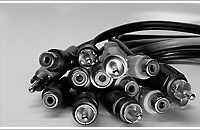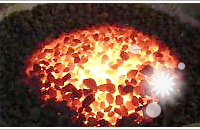Temperature: You can use two kinds of sensors in the industrial systems of temperature measurements: resist and thermoelectric sensors. Depending on the conditions that refer to the measurement system, you can hook up the temperature sensors to indicators, regulators or recorders. On account of the rendition of the temperature sensors and the influence of the contact cords on the measurement precision, gauge converters for standard analogue (current or tension) signals are used very often. Resist sensors are made as platinum or nickel elements. The rules of the measurement base on the influence of the temperature on the sensor resistance. Type of the sensor is specified by the material, that the sensor is made of and by the resistance value of the sensor when the temperature is 0C (for example Pt100 or Pt1000). The dependence between the temperature and the resistance are determined by appropriate norms.
Cover thermoelements
Special technical requirements and uses, for example medical, have lead to the development of the small-sized cover thermoelements that are characterized by the high resist isolation and by the immunity to the aggressive surroundings. The seamless cord of the cover thermoelement consists of: 2 cords (thermoelectrodes) an isolation tier – strongly pressed mineral powder (most often magnesium oxide) metal cover assuring mechanical protection of the chemical measuring weld and thermoelectrode. At the one end thermoelectrodes are welded, so that they create a measuring weld (the hot end of the thermoelement). The thermosteam cover is welded too, so that it isolates measuring weld from external influences. The second end of the thermoelement is connected to the extending or compensatory cord, directly or by the junction plug – socket. Thanks to the very strong pressure of the isolation tier and suitable metallurgical structer, both of the termoelectrodes and of the cover, thermoelements are very supple and can be bent by the minimal curvature vector, that is three times larger than their external diameter. Little external diameters of the thermoelements let measure temperature even at difficult to reach places.
In the system of temperature measurement by using thermoelectrical sensors each cable connection can be a source of intrusive, measurement disturbing, thermoelectrical voltages. All connections of the temperature sensor to the gauge should be done by using a compensatory cord, that is suitable to kind of temperature. Every type of compensatory cable has other isolation with different colours. Making a connection by using an usual copper cable or by using a compensatory cable that is unsuitable to the type of the thermosteam causes that the measure won't be correct.
|

